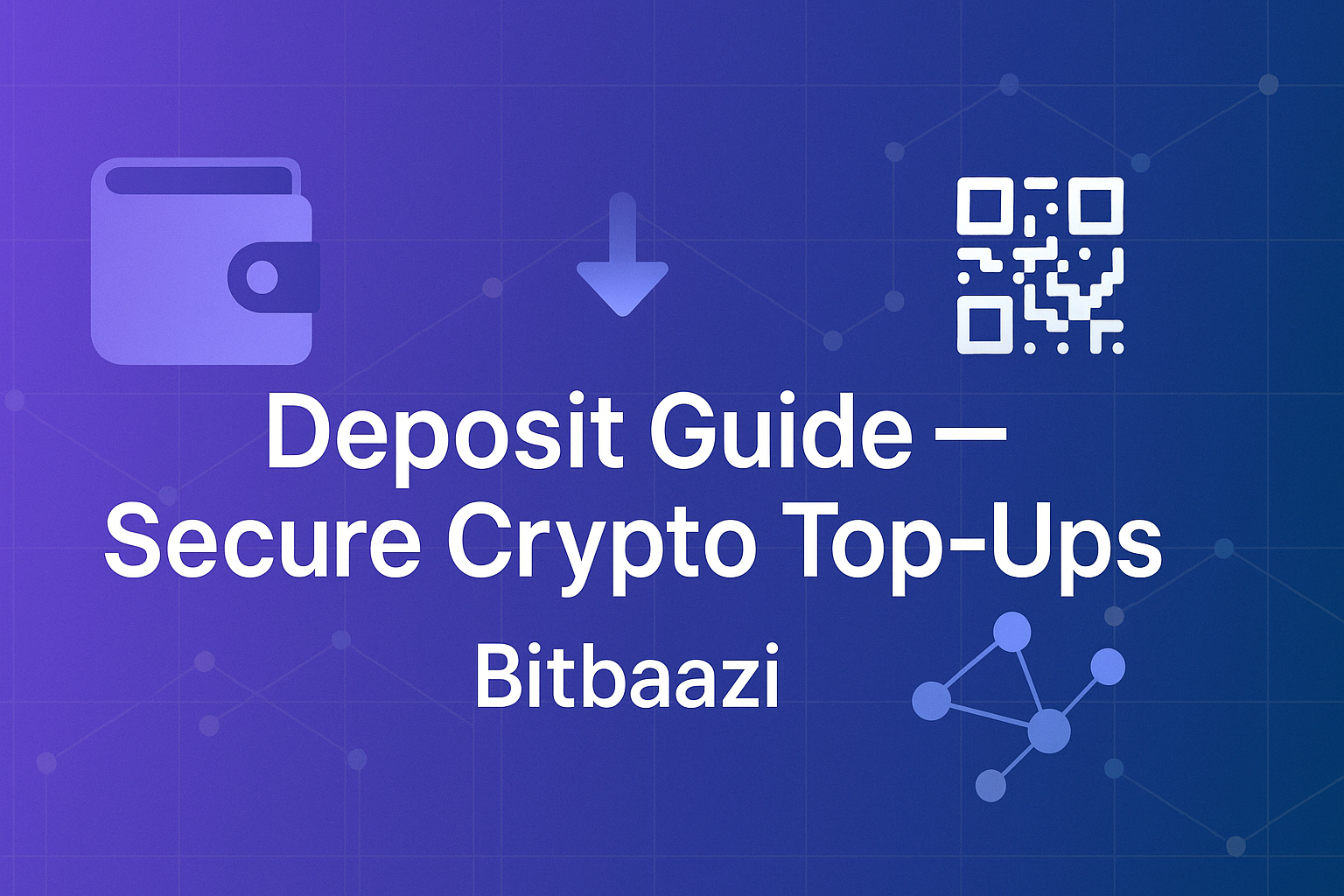Deposit Guide — Secure Crypto Top-Ups | bitbaazi
Summary
- Add funds to an exchange or wallet without costly mistakes.
- Match networks end-to-end and include memos when required.
- Check confirmations, limits, and address status before you send.
Intro. A Deposit brings assets into an exchange or wallet for trading or storage. This guide shows how to add funds safely, avoid wrong-network transfers, and understand memos, confirmations, and address rotation.
What an incoming transfer does
Funds move from a sending wallet to an account the platform credits.
Platforms assign a receiving address per asset and sometimes a secondary identifier. On some networks (e.g., XRP, XLM, EOS) a tag/memo routes your funds within a shared address; omitting it can delay or block crediting on the platform.
Network choice must match end-to-end. If the sender broadcasts on ERC-20 but the receiver expects TRC-20, the transfer won’t map to your balance and recovery may be impossible—always match the chain listed by your platform.
Networks, addresses, and memos
Choose the same chain on both sides and verify any memo requirements.
Chains and address formats differ. Examples include ERC-20 vs TRC-20 for USDT, BEP2 vs BEP20 for BNB, and BTC bech32 (“bc1”) addresses; never pick a network just because the fee looks cheaper—use one your platform explicitly supports for the asset.
Receiving addresses can be rotated or retired. Exchanges periodically upgrade wallets and may mark an old address as expired; new credits go to the fresh address, and late arrivals may need manual crediting via the provider’s tools.
Steps to add funds safely
Use this checklist before initiating the transfer.
1) Confirm support for the asset and chain. Check the asset’s funding page for service status, minimums, and restrictions; sending an unsupported token or via an unsupported network can strand funds and stop crediting.
2) Generate and copy the receiving details. Use the QR or copy function—don’t type addresses; if a tag/memo appears, include it verbatim. Consider a small test top-up before a larger amount to verify routing.
3) Track the transaction on-chain. Use the TxID to monitor progress; the platform credits after required confirmations, which vary by asset and network conditions.
4) If the balance doesn’t update, triage. Common causes include pending confirmations, missing memo/tag, below-minimum amount, maintenance, or an unlisted token; follow the provider’s recovery or status guidance.
FAQ
- USDT via TRC-20 but receiver expected ERC-20—what now?
Networks must match; contact support, but recovery isn’t guaranteed. - Do XRP/XLM/EOS require a memo/tag on exchanges?
Many do; always include the shown memo/tag to avoid delays. - How many confirmations for BTC to appear?
It depends on the platform; check the asset page for the requirement. - My address shows “retired/expired”—is money lost?
Wallets rotate; get a new address and follow manual-credit steps if needed. - Could 2-step verification holds delay crediting?
Yes—complete required security checks for the account to credit.
Takeaways
- Match the network exactly between sender and receiver.
- Include memo/tag when prompted (XRP, XLM, EOS, etc.).
- Copy or scan addresses; avoid manual typing.
- Track by TxID; credit follows required confirmations.
- If stuck, check status pages and follow the provider’s recovery flow.
作用与流程
资金从发送方链上确认后,由平台入账到你的账户。
本文使用“Deposit”指代入金动作。平台会为每种资产生成收款地址,有些链(如 XRP、XLM、EOS)还需标签/备注以在共享地址下定位子账户;缺失会导致延迟或无法入账。
网络必须端到端一致。若发送方走 ERC-20 而接收方期望 TRC-20,交易无法匹配到账,恢复难度大;务必以平台列示的支持链为准。
网络、地址与标签/备注
发送侧与接收侧的链需一致,并确认是否要求标签/备注。
不同链与地址格式差异显著:USDT 常见 ERC-20 与 TRC-20、BNB 有 BEP2 与 BEP20、BTC 有 bech32“bc1”等;不要只因费用低就选链,应以平台明确支持为准。
平台可能轮换或“退休”旧收款地址。钱包升级时旧地址会标记为过期;新的入账应使用新地址,迟到交易可能需要按平台指引进行手动入账。
安全步骤
在发送前用这份清单逐项确认。
1)确认资产与链的支持状态。 在资产资金页查看服务状态、最小额度与限制;不受支持的代币/链会导致无法入账。
2)生成并复制收款信息。 使用二维码或复制功能,避免手输;若提示标签/备注,请逐字填写;大额前可先小额验证路径。
3)用 TxID 追踪进度。 到账依赖所需确认数并受链上拥堵影响,完成后平台才会记账。
4)未入账时的排查。 常见原因包括确认未完成、标签缺失、低于最小额、维护期或代币未上架;按平台状态与恢复流程处理。
入金の役割と流れ
送金元でブロックチェーン上の承認後、プラットフォームが残高に反映する。
ここではDepositを入金の行為として扱う。各資産ごとに受取アドレスが割り当てられ、XRP・XLM・EOS などはタグ/メモで口座内ルーティングを行うため、欠落すると反映が遅延・停止する。
ネットワークは送受の両端で一致が必須。送信側が ERC-20、受信側が TRC-20 を想定していると残高に紐づかず、回復は困難になり得るため、必ずサポート対象のチェーンを選ぶ。
ネットワーク・アドレス・タグ/メモ
送信側と受信側のチェーンを一致させ、メモ要否を確認する。
チェーンとアドレス形式は多様(USDT の ERC-20/TRC-20、BNB の BEP2/BEP20、BTC の bech32 “bc1” など)。手数料だけで選ばず、プラットフォームが明示する対応チェーンを使う。
受取アドレスはローテーションやリタイアがあり得る。旧アドレスが期限表示なら新アドレスを取得し、遅延した着金は案内に沿って手動反映が必要となる場合がある。
安全な進め方
送金前に次のチェックリストを必ず確認する。
1)資産とチェーンの対応状況を確認。 資産ページでステータス・最小額・制限を確認し、不対応のトークン/チェーンは着金しない可能性がある。
2)受取情報を生成し正確に転記。 QR/コピー機能を使い手入力を避ける。タグ/メモが表示されたら必ず記入し、高額前に少額テストを推奨。
3)TxID で進捗を追跡。 反映は必要承認数とネットワーク状況に依存し、完了後に残高へ記帳される。
4)未反映時の切り分け。 承認中、メモ漏れ、最小額未満、メンテナンス、未上場などを確認し、各社のリカバリー手順に従う。
